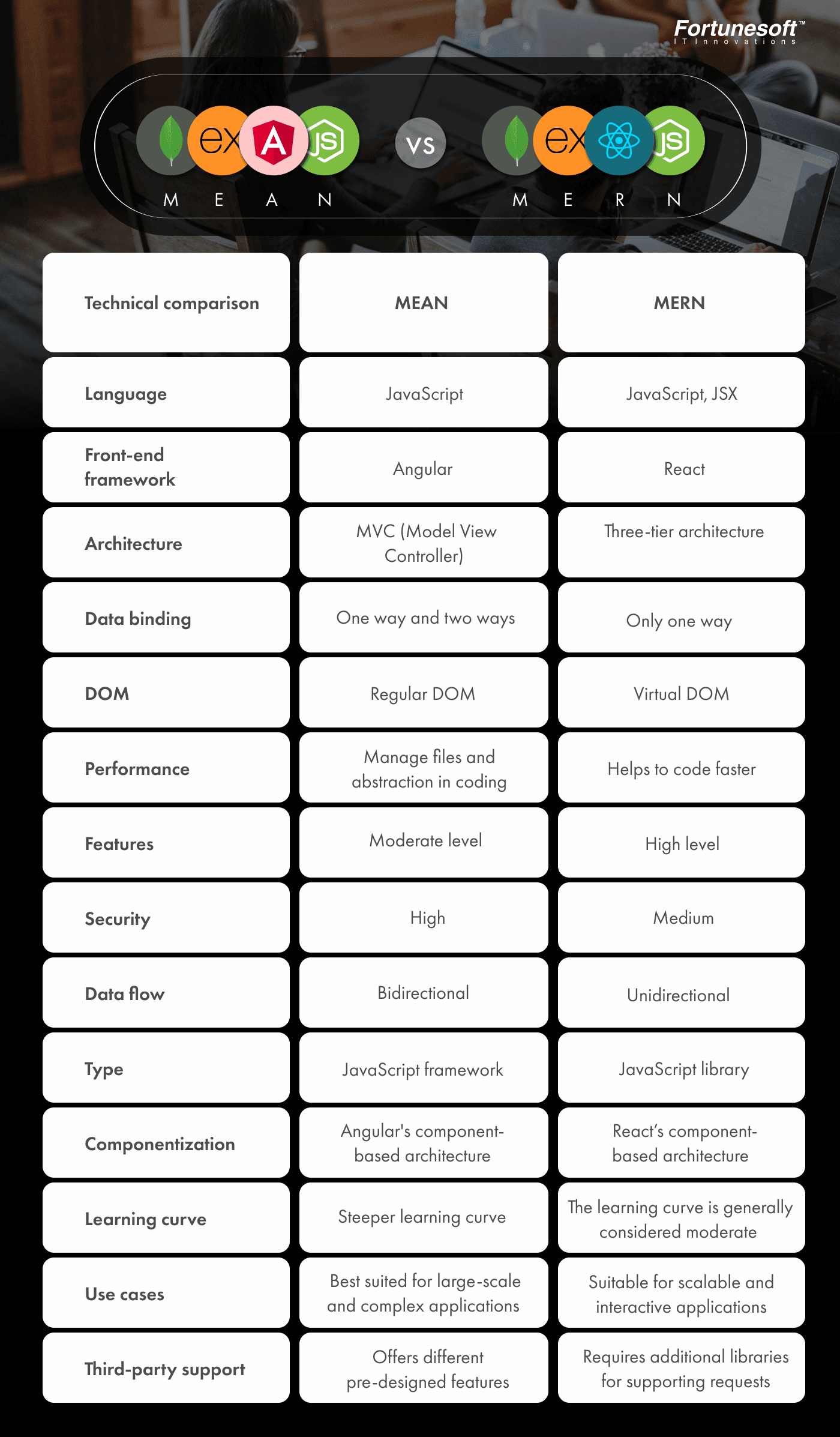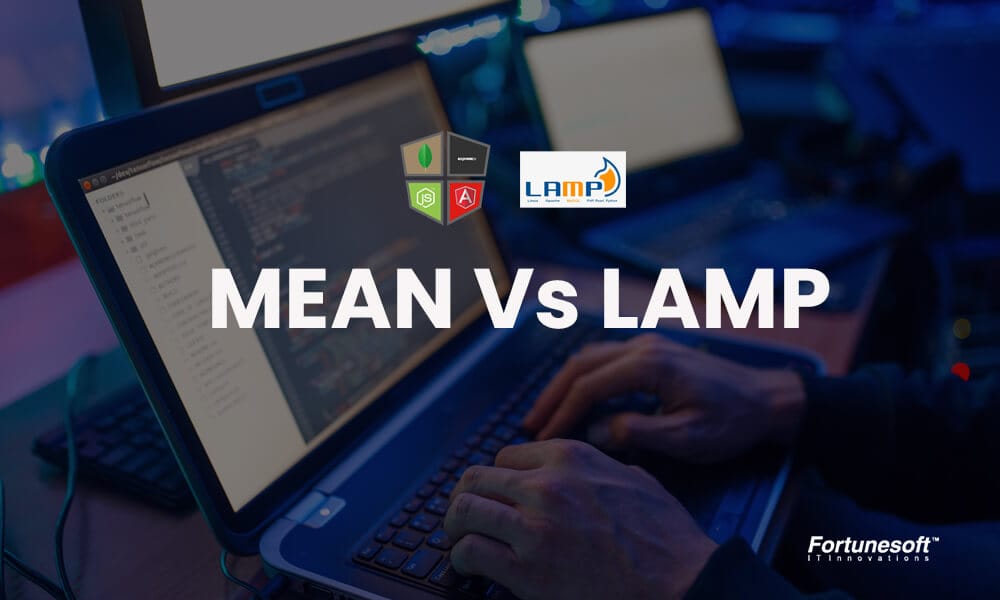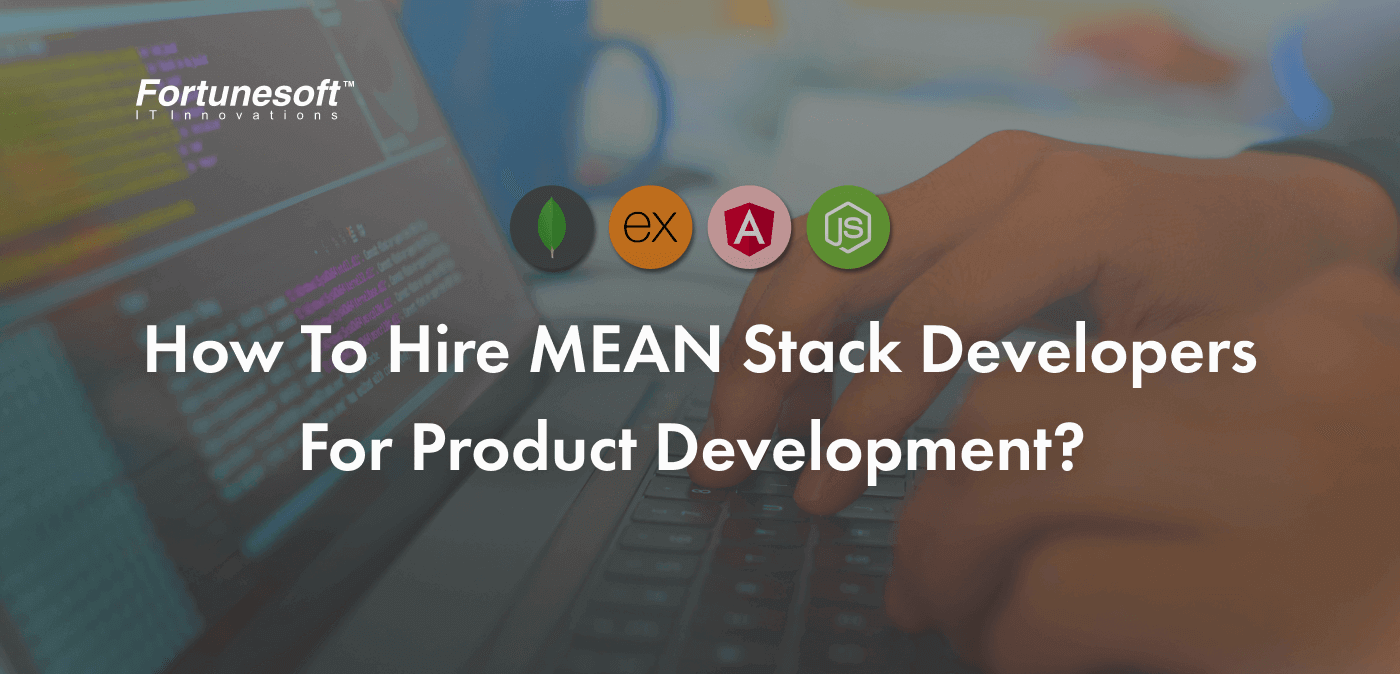 September 20, 2023
min read
September 20, 2023
min readMERN stack VS MEAN stack – Which is the best stack for your product development?
The modern world is revolutionizing digital businesses every day due to the increasing demands of users. Nowadays, people are choosing mobile applications or products based on their performance, responsiveness, features, security aspects, and user-friendliness. So, developing a robust and feature-packed product is not an option; it’s a need to surpass this competitive business arena.
For building a scalable and high-end product, you should pick the best technology stack that benefits your business; and must help to achieve your objectives swiftly. The global tech market is flooded with several technology stacks for developing applications and products. Among them, the MERN stack and MEAN stack are prominent and widely utilized by business owners. This is where the MEAN stack vs. MERN stack debate has begun in the IT industry.
MERN and MEAN stacks are ruling like a sovereign in the web development sector with their mind-blowing attributes. Even though these stacks have some similarities, each has its own unique benefits and characteristics. As a startup, picking the right tech stack for your product development is essential for maximum scalability, performance, and flexibility.
To make the right decision regarding product development, startups must have clarity about the benefits, technical differences, and similarities of these stacks. In this article, we will discuss what MEAN and MERN are along with their amazing perks and other exciting technical aspects.
What is MEAN stack?
MEAN stack is a popular technology stack that simplifies building dynamic websites and mobile applications. It consists of four key technologies: MongoDB, Express.js, Angular, and Node.js. Each technology component is different from each other. MongoDB is a NoSQL database that stores data in a flexible, JSON-like format, making it suitable for handling large amounts of semi-structured data.
Expressjs is a lightweight web application framework for Node.js that helps manage server-side logic and routing. This makes it easier to handle requests and responses. Here comes the main difference between the MERN stack and the MEAN stack. In the MERN stack, you will be using React (JS library) for building the user interfaces of the product. But here, you use Angular, a powerful front-end framework by Google that facilitates the creation of dynamic, single-page applications (SPAs). It handles user interfaces and interactions effectively.
The MEAN stack enables developers to create a sturdy product using a single programming language (JavaScript) throughout the development process. This integration streamlines development and makes Angular development a popular choice for building modern applications and feature-packed products.
Next, let us see…
Advantages of using MEAN stack
- It provides full-stack solutions for product development. So, with the help of MEAN stack developers, you can create both the back-end and front-end of the product utilizing a single tech stack.
- It is an open-source technology stack and cloud compatible, so it would reduce the development cost significantly.
- MEAN stack has Model View Controller (MVC) support.
- It has a vast community, so you can leverage several tools and get excellent support from MEAN stack developers whenever you face complex issues or need solutions.
- Due to the scalability of Nodejs and the adaptability of MongoDB, the MEAN stack is highly scalable.
- The data model of MongoDB and the middleware architecture of ExpressJs provide a lot of flexibility in designing and constructing a robust product.
- MEAN stack authorizes isomorphic coding as it uses JavaScript throughout product development.
- Developers can easily switch server-side and client-side operations.
- With MEAN stack, you can develop and launch your product rapidly in the market.
- It has an extensive built-in tool testing suite.
You can yield all these benefits when you choose the best MEAN stack development service for building your product or web application. Now, it’s time to know what the MERN stack is.
So, let us see.
What is the MERN stack?
MERN stack is a well-known stack utilized for developing full-stack products cost-effectively and rapidly. It is a combination of four technology components, such as MongoDB, ExpressJS, ReactJS, and NodeJS. It came into the IT industry as a replacement for the MEAN stack. When you use the MERN stack, you can build the front end of your product with React, the back end with NodeJS & ExpressJS, and MongoDB for storing the data.
Each technology component of the MERN stack holds different characteristics and functionalities. In the MERN stack, MongoDB is an open-source document database for storing all the necessary data and information. Secondly, Expressjs is a back-end web framework used with Nodejs. Thirdly, React is a popular front-end JavaScript library in the industry for developing intuitive user interfaces. Node.js is a JavaScript runtime environment that helps to run the JS code outside the web browser.
MERN stack assists you in developing a custom product or web application with multiple libraries, frameworks, databases, and much more. The technology components in the MERN stack provide end-to-end support for you to develop a feature-rich product and application with ease.
Benefits of using MERN stack
Here is the list of advantages that you can get when you prefer the MERN stack for your product development or web application development.
- Like the MEAN stack, MERN is also devised completely on a single technology, JavaScript.
- The product development team can easily switch between front-end and back-end.
- High performance and scalability are possible with the MERN stack because Nodejs is used for server-side programming.
- The modular architecture of the MERN stack enables you to reuse the code and UI components. So, it automatically reduces your development time and accelerates the product creation process.
- Supports MVC architecture.
- Easy code maintenance and instant product development.
- It has a strong and big community, so you can leverage the required tools, resources, frameworks, tutorials, and high-end support from the community. This makes your app development or product development process much easier.
- Combination of the best technologies, such as MongoDB, Expressjs, Nodejs, and Reactjs.
- The MERN stack is faster, better, and more optimized to create products because it offers a flexible data model with a dynamic schema.
- Complete coverage of the product development cycle.
As a startup or a business owner, you can get all these extraordinary perks by utilizing the first-class MERN stack development service from the leading product engineering firm.
We hope you have gained significant knowledge of the MERN and MEAN stack. Now, it is time for you to know their technical differences. So, let us dive into the fascinating section of the article.
MERN stack vs MEAN stack – A technical comparison
Knowing the technical difference between MERN and MEAN is crucial for making an informed decision for product development. Also, you could know which fits the best for your business needs and requirements.

Next, let us see.
MERN stack vs MEAN stack – Key similarities
As stated earlier, MEAN and MERN are both popular choices for developing products and dynamic web applications. However, these two tech stacks have many things in common and share core similarities in their fundamental components & architecture.
Let us see those technical similarities.
- Both MERN and MEAN stacks are based on JavaScript, which promotes consistency in coding throughout the application layers.
- MongoDB serves as the DMS for both stacks and provides a NoSQL solution that accommodates flexible and unstructured data storage.
- Express.js is employed as the server-side framework for routing and middleware tasks in both MERN and MEAN stacks.
- Node.js forms the core of the server environment in both stacks, which fosters efficient real-time communication. And allows JavaScript to be used on the server side.
- The technologies used in both stacks are open source.
- The use of non-blocking I/O operations in Node.js, coupled with MongoDB’s scalability features, allows both stacks to handle large numbers of concurrent users effectively.
- The architectural similarities between MERN and MEAN stacks enable developers to quickly switch between them.
These are the pivotal similarities between MERN and MEAN. So far, you have explored the differences and similarities between MERN and MEAN. Now, you need to choose the best technology stack for your product creation.
MERN stack vs. MEAN stack – Which one to choose?
Based on the technical comparison of the MEAN vs. MERN stack and its similarities, it is clear that both stacks have their own set of merits. The vital difference between these stacks lies in their structure. As a startup or a business owner, the MEAN stack will be a great option for building large-scale applications. And the MERN stack will be ideal for the rapid development of smaller applications.
To make the right decision, consider factors like product scope, development speed, team expertise, scalability, and long-term maintenance. Assess whether the opinionated structure of MEAN suits your project’s complexity or if MERN’s flexibility aligns better with your business requirements. It’s also prudent to gauge the proficiency of your team in Angular and React, as this can influence the tech stack selection.
Ultimately, the best choice depends on a balance between product demands, team skills, and goals. Evaluating these aspects comprehensively will help you to pick the best stack for your product development.
Author Bio


 Facebook
Facebook Whatsapp
Whatsapp LinkedIn
LinkedIn Pinterest
Pinterest








 Start Chat
Start Chat